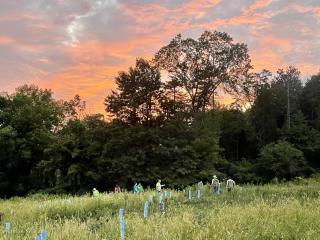Portage Park District Plants 30 acres of Trees in honor of 30th Anniversary
Author: Bob Lange, Natural Areas Steward
Posted on: December 1, 2021 - 9:42am

As challenges to forest health, including invasive species, disease and fragmentation continue to mount, Portage Park District aims to do its part to improve and increase the forested landscape for our future. In commemoration of its 30th anniversary, Portage Park District reforested 30 acres in 2021 with the help of a generous gift of $30,000 from the Portage Park District Foundation.
Highlights from the 2021 Reforestation Effort
- The majority of tree planting occurred in April and May of 2021. Planting at Tinkers Creek Greenway was completed for the year during this time. Eagle Creek Greenway was partially completed, with the remainder of the planting finished up in the fall.
- Spring planting included all bare-root seedlings. PPD staff and volunteers were assisted by staff and students from the following agencies and schools:
- Hiram College
- Kent State University
- Theodore Roosevelt High School Urban Forestry and Landscape Management
- Protective grow tubes purchased for the spring seedlings were installed by staff and volunteers throughout the year. You can see these blue tubes at Trail Lake Park along the Osprey Loop.
- Eagle Creek Greenway planting for 2021 was completed in September with the planting of 170 saplings in 3-gallon pots as a project of the Leadership Portage County Class of 2021.
- Wire fence cages were installed immediately to protect the larger fall trees
- At project completion, approximately 31 acres were reforested at Portage Park District in 2021.
Download the full analysis of this project including planting design and rationale here.
Forests for our Future
Planting trees and reforesting aligns with our mission to conserve Portage County’s natural heritage in many ways (Adapted from https://www.nationalforests.org/get-involved/tree-planting-programs/benefits-of-reforestation):
- Forests supply clean water that supports life in all forms. Forests shade and cool our streams, reduce flooding, reduce erosion, and filter sediment to improve water quality. Reforesting along our streams and other water resources is essential to protecting our water supply.
- Reforesting disturbed landscapes with a variety of species makes our forest communities more resilient to future challenges such as invasive species and changes in growing conditions.
- Forests provide critical habitats for wildlife and vascular plant communities. As our forests in Portage County become more fragmented, wildlife species such as some of our breeding birds face further population declines because there is not enough deep forest for successful nesting. Diminished water quality impacts our diverse aquatic animal communities. Rare vascular plant communities and plant species dependent on forests are more easily affected by invasive plants and herbivory. Reforesting to expand existing forest can create large blocks of unbroken, contiguous habitat, ensuring the conservation of forest-dependent species and promoting biodiversity.
- Land that has long been deforested can take an estimated 150 years to become forest again through natural processes. An established forest can be removed and converted to another use in less than a year. Active reforestation helps to mitigate such changes.
- Forests offset our emissions by supporting and increasing carbon sequestration potential.
- Planted trees become seed sources that contribute to natural succession and the spread of forest cover.
- Forests provide space for peace, renewal, and recreation for our mental and physical health and enjoyment.

